Project Management Statistics – By Causes of Project Failures, Software Features, KPIs of Projects, Demographics, Education Qualifications, Gender Pay Gap, Job Tenure

Page Contents
- Introduction
- Editor’s Choice
- What is Project Management?
- Various Project Management Approaches
- Top Project Management Tools to Use in 2023
- Benefits of Project Management
- General Project Management Statistics
- Project Management by Causes of Project Failures
- Project Management by Software Features
- Project Management Statistics by KPIs of Projects
- Project Management Statistics by Demographics
- Project Management Statistics by Education Qualifications
- Project Management Statistics by Gender Pay Gap
- Project Management Statistics by Job Tenure
- Conclusion
Introduction
Project Management Statistics: Project management is the most crucial part of every organization, be it healthcare, IT, technology, education, or any other industry everything has to go through project management at some point. Today, project management is known as the most important factor in terms of enhancing organizational workflow. Due to technological developments, we live in an AI and technology-driven world. Software created by these factors is aided in many possible ways. Just like this, unlike old manual work days, PM can be completed and achieved by using similar software. These Project Management Statistics show that how today companies are adopting this technology and achieving their company goals.
Editor’s Choice
- By 2030, it is predicted that around 2.3 million candidates will get positions in project management roles.
- The global project management software market demand is expected to reach $9.81 billion by 2026 at a CAGR of 10.67%.
- 75% of the project managers believe that using software will lead to poor management.
- Around 33% of the organizations achieve bigger tangible goals along with individual projects while 67% of the projects are yet circled with traditional outputs such as budget, time, and scope.
- Project Management Statistics state that there is a proven correlation between higher budgets and failure rates.
- 60% of the managers prefer to use hybrid methods such as Predictive and Iterative methods to deliver projects.
- 91% of the teams working in Project Management have reported utilization of virtual tools for remote work.
- Gartner Inc. forecasts that by 2030, 80% of the work related to projected management will be reduced due to the application of Artificial Intelligence (AI).
- 78% of the companies stated their primary KPI for project management is to meet original goals, while 67% said they put forth their KPI to complete the project within budget.
- High performers in project management save up to $125K for every project, while low performers save up to 8K per project.
What is Project Management?
Project Management is the process of managing a defined project to its completion of achieving goals. It includes leading the team members. The major factors that could affect the success of the project are scope, budget, and time.
Various Project Management Approaches
- Agile – This approach is built on small and incremental steps. It has flexibility and can be used during software development projects where changes are extremely constant. Moreover, it can be used when a company is launching a new product without having enough knowledge of the changes or trends in the market.
- Waterfall – In the waterfall approach, there are restrictions towards constant changes as it goes on with few anticipated changes and strict expectations. It can be used during building houses, where completion of one stage is compulsory before moving to another phase. This way it will gain projected outcomes.
- Lean – Lean approach is applicable when the project is related to the manufacturing industry. This approach is aided in reducing costs, and timelines and enhances customer satisfaction. It also has a flexible approach.
- Scrum – The Scrum approach provides Agile factors by means of small teams, frequent communication, and short development cycles. It also has a way to solve problems and adapt to changes.
- Kanban – Kanban means visualization of the workflow of a project. This approach is suited for projects that have multiple tasks to be completed simultaneously.
Top Project Management Tools to Use in 2023
Jira: Product Development teams
Teamwork: Client Facing Service Providers
Wrike: Artificial Intelligence Features
Smartsheet: Workflow Automation
Asana: Collaboration tools
Monday.com: Startups being on a tight budget
ClickUp: Agile Development Teams
Zoho Projects: Integrations
Notion: Content Creators
Airable: Data-Driven Companies
Benefits of Project Management
- Increase in overall productivity
- Decreased project costs because of the automation
- Accurate results
- Improved standing on the competitive edge
- Quality performance and development within the team
- Improved flexibility during the completion of project tenure
- Improved risk assessment
- Enhanced customer satisfaction
- Efficient project submissions
General Project Management Statistics
- The global project management software market demand is expected to reach $9.81 billion by 2026 at a CAGR of 10.67%.
- 51% of the companies prefer to employ project managers with some kind of certification for their roles.
- By 2030, it is predicted that around 2.3 million candidates will get positions in project management roles.
- Gartner Inc. forecasts that by 2030, 80% of the work related to projected management will be reduced due to the application of Artificial Intelligence (AI).
- 91% of the teams working in Project Management have reported utilization of virtual tools for remote work.
- 43% of the companies stated that they were able to complete their projects within the allotted budget most of the time or ”always”.
- Project Management Statistics state that there is a proven correlation between higher budgets and failure rates.
- Shiting to modern Project Management Tools can aid in saving 20% of costs and increasing productivity by 50%.
- Only 32% of the companies hire full-time project managers while the majority of the companies go with outsourcing or contract-based project management.
- High performers in project management save up to $125K for every project, while low performers save up to 8K per project.
- High-performing companies successfully manage to complete 80% or more of their given project while low performing can go up to 60%
- Top-performing companies are 49% more likely to have a project management process in place for 5 or more years while it goes 24% for low performers.
- 56% of the project managers are very or somewhat dissatisfied with the current state of PM maturity.
- It is said that, if the management takes 5 or more hours to make a decision then the project is 22% likely to fail in the future.
- Around 33% of the organizations achieve bigger tangible goals along with individual projects while 67% of the projects are yet circled with traditional outputs such as budget, time, and scope.
- According to some experts, 9.9% of every dollar is wasted because of poor project performance.
- 77% of the top-performing projects use project management software, whereas, 44% of the managers do not prefer to use any such software.
- 75% of the project managers believe that using software will lead to poor management.
- 60% of the managers prefer to use hybrid methods such as Predictive and Iterative methods to deliver projects.
- 40% of the project teams include 6 to 10 team members.
- 74% of the employees believe that in the coming years, more project managers will prefer to work from home.
- 42% of the PMs say that their organizations don’t value project management.
- 15% of the employees who work as project managers think that they will lose their jobs.
- Around 11% of the managers lead 6 to 10 projects at once while 15% lead more than 10 projects.
- 27% of the projects go over budget.
- 25% of the companies never or sometimes provide scoping documents related to projects.
- 11% of the Agile projects fail and end up delivering nothing.
- 47% of the agile projects are delivered late because of budget issues and cause customer dissatisfaction.
- Project Management software saves around 498 hours of average employee time every year.
- Around 50% of the project managers spend 2 or more days manually gathering KPI reports related to the project.
- The majority of the organizations say that completing the project on time is the biggest challenge.
- Around the world, only 45% of the staff members are Project management Professionals or PMP certified.
- 25% of the managers agree to not having their roles clearly defined, however, 44% of managers agree to vice versa.
- Only 45% of the companies have PM training programs held as per the requirements.
- 4 out of 10 employees believe that the projects they have worked on are or were a complete success.
- It said that 10% of projects tend to fail because of the project management methodology.
- 50% of IT projects that have a minimum of $1 million in funds are not able to meet their goals.
- 61% of the companies complete their projects before the deadline using project management tools.
- Poor communication between teams could lead to $420,00 of losses in a single year with less than 100 employees.
- 71% of managers state the topmost priority for project completion is communication between employees.
- The majority of the project managers are not happy with the technology they are using.
- 54% of the team members believe that by using automation tools 5 hours or more of the work can be saved.
- As of today, only 2.5% of companies have reported completing their projects 100% successfully.
- The majority of the project managers reported hectic workload as the main reason for employee burnout.
- Project management Statistics show that reworking a project is a waste of time.
- 20% of the project managers don’t like the project documentation.
- PMP-certified employees earn 23% more than those without it.
- The most in-demand skills for project managers are Technical skills (68%), Leadership Skills (65%), Business skills (58%) and Digital skills (50%).
- 62% of the companies successfully completed their projects with the help of sponsors.
- Stakeholder engagement is the most important factor in project management success.
- 68% of the projects are without effective sponsors.
- 27% of the companies use risk management practices during the project tenure.
Project Management by Causes of Project Failures

(Source: financesonline.com)
The top three reasons that cause the project to fail are Changes in the organization's priorities (39%), Changes in Project Objectives (37%), and Inaccurate requirement gatherings (35%). Some companies similarly marked inadequate vision or goal, poor communication, and poorly defined opportunities and risks resulting in 29%. Only 25% of the companies said inaccurate time estimates can lead the project to fail.
Project Management by Software Features
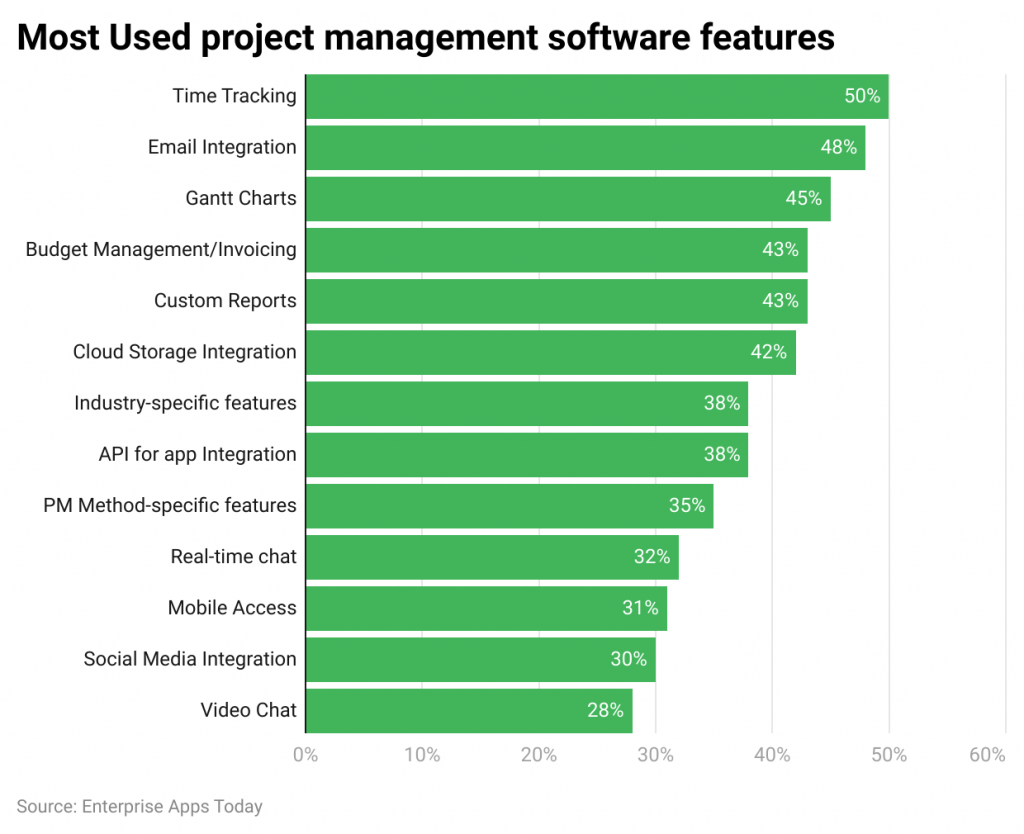 (Source: flowlu.com)
(Source: flowlu.com)
The top three PM Software features commonly used by the project leaders are file sharing (51%), Time Tracking (50%), and Email Integration (48%). The least used software features include Mobile access (31%), Social media integration (30%), and Video Chat (28%).
Project Management Statistics by KPIs of Projects
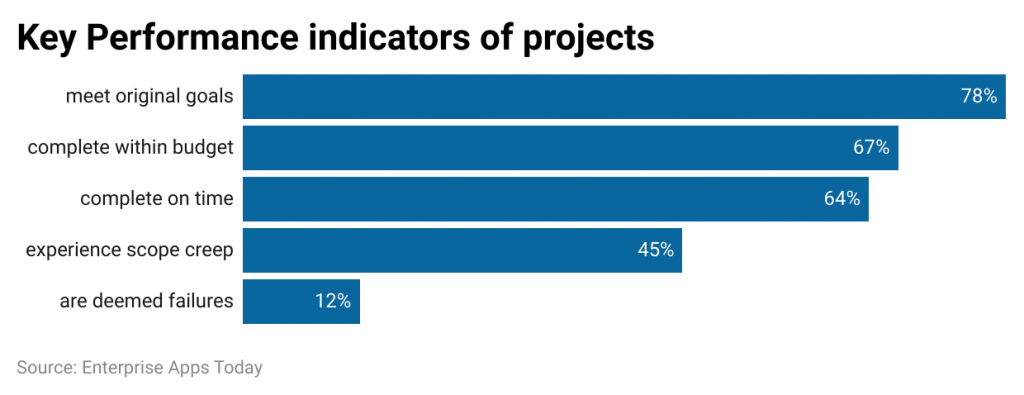 (Source: financesonline.com)
(Source: financesonline.com)
78% of the companies stated their primary KPI for project management is to meet original goals, while 67% said they put forth their KPI to complete the project within budget. There are only 12% of companies whose KPIs include projects that are deemed failures.
Project Management Statistics by Demographics
By gender
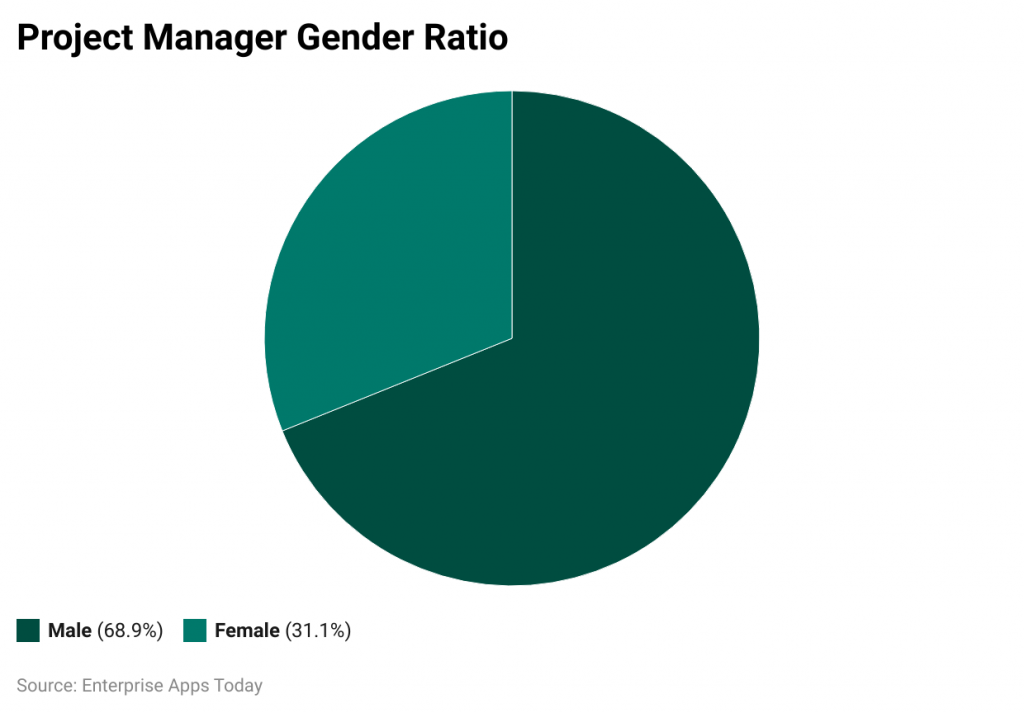 (Source: zippia.com)
(Source: zippia.com)
Looking at the Project Management Statistics by demographics it is clear that this is a male-dominated industry having 68.9% of male employees as compared to female employees 31.1%.
By Ethnicity
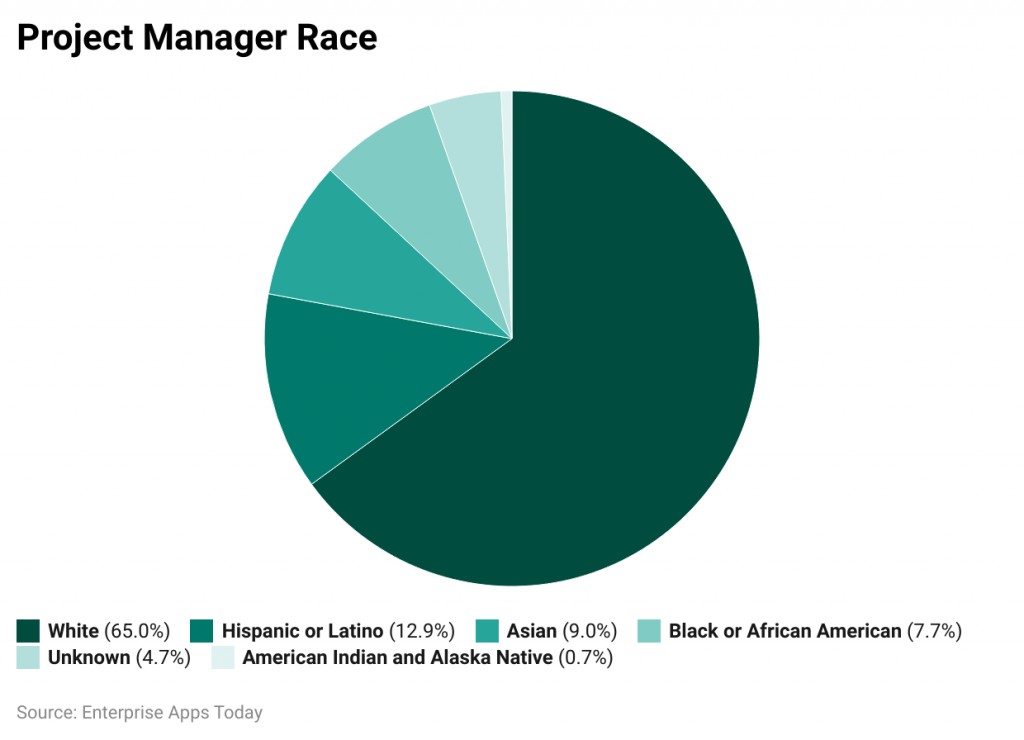 (Source: zippia.com)
(Source: zippia.com)
The majority of the employees in the Project Management field are white by background resulting in 65% followed by Hispanic or Latino (12.9%) and Asian (9%). The lowest number of project managers belong to American Indians or Alaska natives resulting in 0.7%.
Project Management Statistics by Education Qualifications
 (Source: zippia.com)
(Source: zippia.com)
The majority of the project managers have bachelor's degrees resulting in 68%, while 14% and 11% have earned their master's and associate degrees respectively. There are only 4% employees with other degree and 3% with high school diploma.
Project Management Statistics by Gender Pay Gap
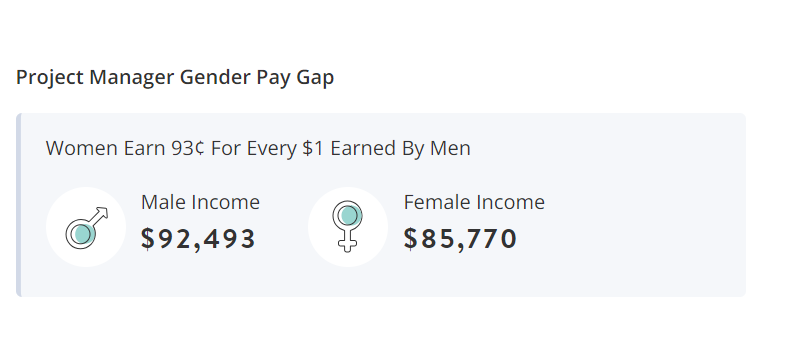 (Source: zippia.com)
(Source: zippia.com)
For every $1 earned by male employees, female employees earn 95 cents. On average male income goes up to $92,493 per annum while it is $85,770 for female employees.
Project Management Statistics by Job Tenure
Project Manager Tenure Statistics
| Number of years | Percentage |
|---|---|
| Less than 1 year | 18% |
| 8-10 years | 6% |
| 5-7 years | 15% |
| 3-4 years | 16% |
| 11+ years | 8% |
| 1-2 years | 37% |
(Source: zippia.com)
Approx. 37% of the project managers continue to work with the same company for at least 1 to 2 years, followed by 16% for 3 to 4 years and 15% for 5 to 7 years. However, there are only 8% of employees working more than 11 years.
Conclusion
If you are looking for a career in Project Management, you should definitely go for it. As per the Project Management Statistics, it is a growing career path with widely available industries. There won’t be any company where PM is not set. Having a perfect plan and the perfect mindset to execute it will lead to the successful completion of the projects by reaching the company’s goals. Today, companies are offering remote jobs with the help of various software. You can either work full-time or on a contract basis.
Sources
FAQ.
In order to become a project manager you should be PMP certified, these certificates can be gained through, universities, colleges, or online courses.
As of 2023, the average salary in the United States of America for project managers is $96,646 per annum.
The following steps should be taken to achieve a successful project completion;
1) Defining objectives and goals
2) Setting success criteria
3) Understanding stakeholders and their roles
4) Setting the budget
5) Rule out time, budget, schedule, deliverables, etc
6) Create a team
7) And share your plan
Organization, Problem-solving, teamwork, collaboration, leadership, and critical thinking are demanding critical skills of a project manager.
It is a form of a document that contains information about the project’s scope, stakeholders’ information, and objective as well as other important requirements.

Barry is a lover of everything technology. Figuring out how the software works and creating content to shed more light on the value it offers users is his favorite pastime. When not evaluating apps or programs, he's busy trying out new healthy recipes, doing yoga, meditating, or taking nature walks with his little one.